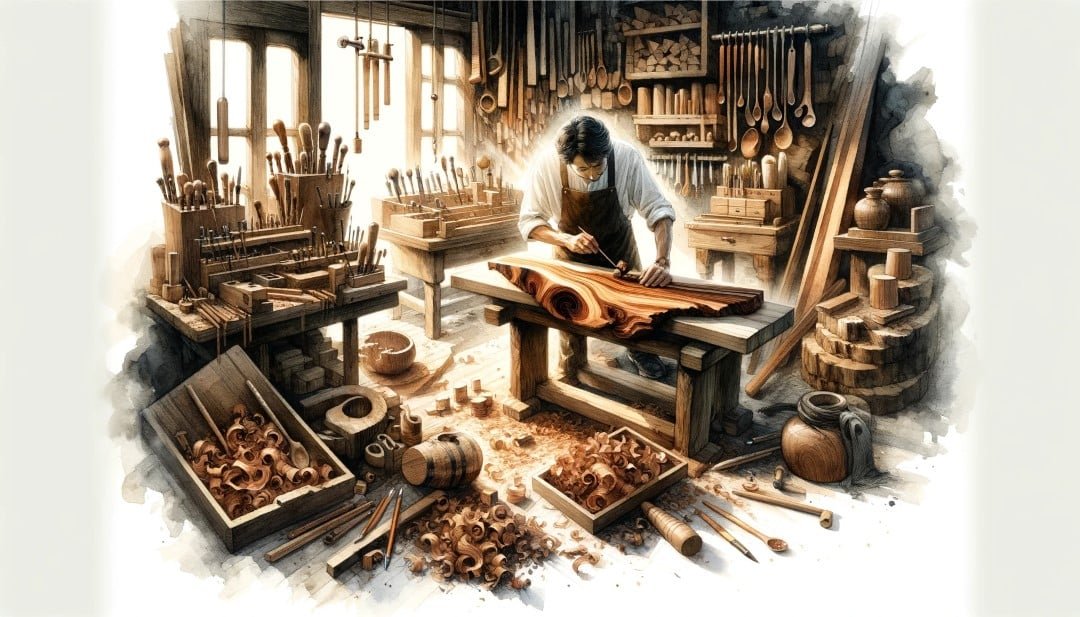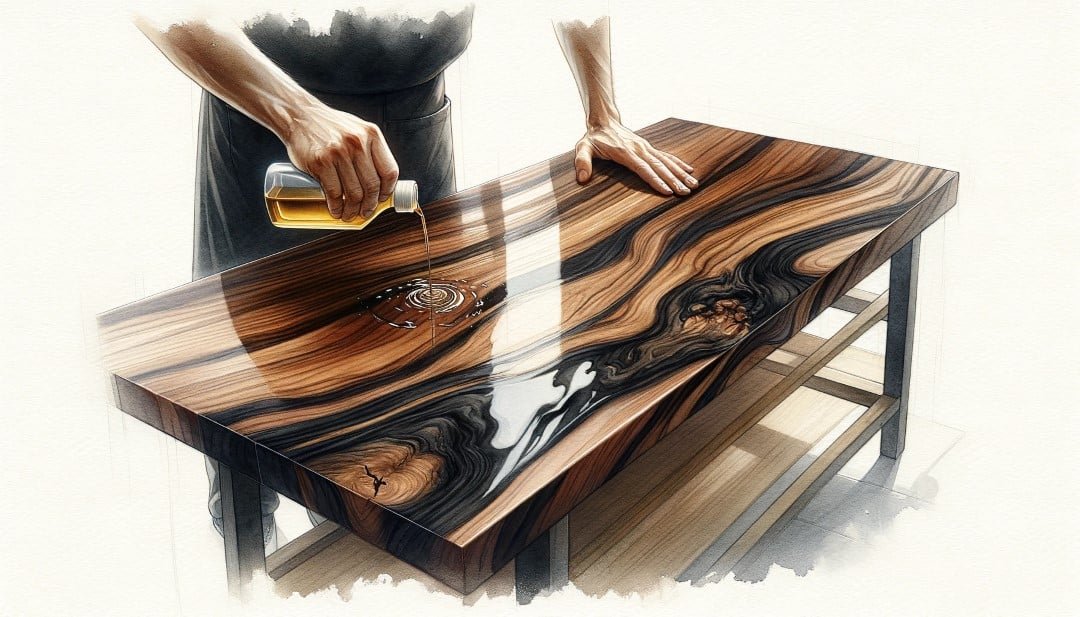
Black Walnut Wood Unveiled: 10 Remarkable Qualities

Welcome to a comprehensive exploration of one of nature’s most esteemed treasures: black walnut wood. Black walnut is known for its deep color, unique grain patterns, and strong durability. It has found its place in woodworking, furniture design, and even art. Let’s go on a journey to discover the secrets of this amazing material. We will explore its history, modern uses, and more.
Table of Contents
Introduction
The Essence of Black Walnut Wood
Imagine the warmth and beauty that a piece of furniture brings to a room. This is not just any furniture. It is made from beautiful black walnut wood. It’s not just wood; it’s a statement of timeless beauty and resilience. In this article, we explore the world of it. This material has been valued for centuries for its unique quality and beauty.
Overview of Its Significance and Applications
Black walnut wood is special in our lives. It is found in grand dining tables for family gatherings. It also features in the delicate carvings that decorate our homes. But what makes it so special? Let’s find out as we explore its origins, properties, and the multitude of ways it enriches our lives.
Part I: Understanding Black Walnut Wood
Characteristics of Walnut Wood


| Characteristic | Description |
|---|---|
| Common Name(s) | Black Walnut, Eastern Black Walnut, American Walnut |
| Scientific Name | Juglans nigra |
| Distribution | Eastern North America |
| Tree Size | 80-120 feet tall (24-36 meters); Trunk diameter of 2-4 feet (0.6-1.2 meters) |
| Average Dried Weight | 38 lbs/ft³ (610 kg/m³) |
| Specific Gravity | Basic: 0.55, 12% MC: 0.56 |
| Janka Hardness | 1,010 lbf (4,500 N) |
| Modulus of Rupture | 14,600 lbf/in² (100 MPa) |
| Elastic Modulus | 1,670,000 lbf/in² (11.5 GPa) |
| Crushing Strength | 7,700 lbf/in² (53.1 MPa) |
| Shrinkage | Radial: 4.8%, Tangential: 7.8%, Volumetric: 12.4%, T/R Ratio: 1.6 |
Origins and Distribution
The Black Walnut Tree: An American Heritage
The story of it begins in the vast forests of eastern North America. This majestic tree, known scientifically as Juglans nigra, stands as a testament to the continent’s rich natural heritage. The black walnut tree grows well in the rich soils of the United States’ heartland. It provides valuable wood and is part of American history.
Geographic Spread and Ideal Growing Conditions
From the cool climates of Ontario to the warm, moist regions of Texas, the black walnut tree has a broad habitat range. It prefers deep, well-drained soils in river valleys and floodplains. Here, it grows tall and strong, with a wide canopy.
Botanical Profile
Taxonomy and Characteristics of the Black Walnut Tree
Diving deeper into its plant details, Juglans nigra belongs to the Juglandaceae family. This family includes different types of walnuts and hickories. The black walnut tree has dark, rough bark and big, compound leaves. This makes it easy to tell apart from other trees.
Differentiating Black Walnut from Other Walnut Varieties
While several walnut species grace our forests and gardens, black walnut stands out. Black walnut wood is darker and denser than English walnut wood. It has a unique grain pattern that woodworkers and artists love.
Historical Uses and Cultural Significance
Early Uses by Indigenous Peoples and Settlers
Long before European settlers arrived, indigenous peoples of North America recognized the value of the black walnut tree. From crafting durable bows to using the nuts for food and dye, this tree has been integral to survival and culture.
Black Walnut in American Woodworking Tradition
As settlers began to forge their new lives, the qualities of walnut wood quickly became apparent. It became a material of choice for furniture, flooring, and gunstocks, its durability and beauty unmatched. This tradition of craftsmanship continues today. Walnut is still a symbol of quality and elegance in woodworking.
Part II: Physical and Chemical Properties
A. Texture, Color, and Grain
The Unique Aesthetic Appeal of it
What sets black walnut apart is its rich, chocolate brown color, often with purplish hues and deep, swirling grain patterns that captivate the eye. Its texture is fine yet dense, making it a pleasure to work with and a beauty to behold.
Grain Patterns: From Straight to Figured
The grain can vary a lot. It can have straight, classic lines for a smooth look. Or it can have figured patterns that show the tree’s life story. These patterns are not just visually appealing; they add character and depth to any piece made from this wood.
B. Durability and Resistance
Inherent Strength and Longevity
is renowned for its strength and durability. Its dense, hard nature makes it resistant to wear and tear, ensuring that items made from it stand the test of time.
Resistance to Pests and Decay
Another remarkable feature of black walnut is its natural resistance to decay and pests, including insects and fungi. This resistance makes it a great choice for indoor and outdoor use, from fine furniture to outside building features.
C. Working Properties
Machining, Finishing, and Joinery Techniques
Despite its hardness, black walnut is surprisingly workable. It machines easily and sands to a smooth finish. It also accepts many stains and finishes. This lets woodworkers show its natural beauty or change its look to match their vision.
Challenges and Solutions in Working with it
While working with it can be a woodworker’s dream, it does come with its challenges, such as its tendency to blunt cutting tools. With the right techniques and some patience, you can easily overcome these challenges. This will lead to beautiful pieces that show off the wood’s natural beauty.
Part III: Applications and Uses

A. Furniture and Cabinetry
Timeless Elegance in Home Décor
The use of black walnut in furniture and cabinetry is a tradition that speaks of elegance and sophistication. Whether it’s a sleek, modern coffee table or a stately, antique armoire, storage boxes add a unique touch of class.
Crafting Techniques Specific to Walnut
Crafting with it requires a keen eye and a skilled hand. Artisans use techniques like book-matching the grain to create beautiful tabletops. They also use traditional joinery methods to enhance the material’s strength.
B. Architectural Woodwork
Black Walnut in Flooring, Paneling, and Trim
Black walnut’s durability and aesthetic appeal make it a popular choice for architectural woodwork. Its rich color and beautiful grain patterns add warmth and depth to rooms. This makes it a popular choice for flooring, paneling, and trim in luxury homes and buildings.
Historic and Modern Architectural Examples
From the historic mansions of the American South to modern boutique hotels, its woodwork shows quality and beauty. Its timeless appeal bridges the gap between past and present, adding character and elegance to any space.
C. Specialty Items and Artistic Endeavors
Musical Instruments and Decorative Carvings
Black walnut has great sound qualities. This makes it a good choice for musical instruments like guitars and violins. It helps improve the instrument’s tone and looks. Its workability and beauty make it a popular choice for decorative carvings and sculptures. This wood shows great artistic potential.
The Role of it in Contemporary Art and Design
In the realm of contemporary art and design, black walnut continues to inspire. Artists and designers use its natural beauty and strength to make pieces that are both useful and artistic. They push the limits of traditional woodworking and design.
Part IV: Sustainability and Environmental Impact
A. Conservation Efforts
The Status of Black Walnut Populations
While black walnut is highly valued, it is also important to consider its environmental impact and conservation status. Efforts are being made to manage i populations sustainably. We want to balance the demand for this valuable wood with the need to protect our forests for future generations.
Initiatives for Sustainable Harvesting
Sustainable harvesting practices, such as selective logging and replanting, are essential in maintaining healthy black walnut populations. These efforts help the environment and provide a steady supply of black walnut wood for many years.
B. Black Walnut as an Eco-friendly Choice
Comparing the Environmental Footprint with Other Woods
When compared to other hardwoods, black walnut stands out as an eco-friendly choice. Its natural resistance to decay and pests lowers the need for chemical treatments. This makes it a better choice for the environment and our homes.
The Role of it in Supporting Biodiversity
The black walnut tree plays a crucial role in supporting biodiversity. Its nuts provide food for wildlife, while its canopy offers habitat and protection. By choosing it, we not only enjoy its beauty but also contribute to the health of our ecosystems.
Part V: Market Insights and Economic Impact

A. Global Demand and Supply Dynamics
Understanding the Market for Black Walnut Wood
The market for it is both dynamic and complex. High demand, particularly for high-quality lumber, combined with limited supply, often results in premium prices. Understanding these market forces is crucial for both consumers and producers.
Factors Influencing Price and Availability
Many factors affect the price and availability of black walnut wood. These include where it is located, the quality of the wood, and current market trends. Staying informed about these factors can help buyers make educated decisions and find the best value.
B. Investing in Walnut
The Investment Potential of Walnut Timber
For those looking to invest in timber, walnut represents a promising opportunity. Its value tends to increase over time, making it a wise choice for long-term investment. However, potential investors should consider environmental and market variables before making a decision.
Future Trends and Market Predictions
As trends in interior design and woodworking continue to evolve, the demand for it is expected to remain strong. New methods for sustainable harvesting and management will likely be important for the future of the walnut market.
Part VI: Maintenance and Care

A. Best Practices for Black Walnut Wood Care
Preserving the Beauty of Walnut Furniture and Features
To keep black walnut pieces beautiful and strong, it’s important to follow good care and maintenance practices. Regular cleaning with the right products can help. Protect surfaces from too much moisture and heat. Periodic oiling will keep it looking great.
Tips for Cleaning and Maintenance
A few simple tips can go a long way in caring for walnut wood. Avoid harsh chemicals, use coasters to prevent water rings, and dust regularly with a soft, dry cloth. For deeper cleaning, a mild, wood-specific cleaner can be used sparingly.
B. Restoration and Refinishing
Techniques for Restoring Aged or Damaged Walnut Pieces
Over time, walnut furniture and woodwork may require restoration or refinishing to return to their original splendor. Techniques such as sanding, staining, and sealing can revitalize old or damaged pieces, extending their life and beauty.
When to Seek Professional Help
Many maintenance and restoration tasks can be done by a DIY enthusiast. However, some situations need professional help. Complex repairs, detailed refinishing, or restoring valuable antiques are best done by experts. They specialize in this work.
Conclusion
Black walnut wood has a rich history and many great qualities. It is used in many different ways, showing nature’s gifts. Black walnut comes from the forests of North America. It inspires artisans and people around the world. By using sustainable practices and new ideas, we ensure that woodworking will have a lasting legacy. This will bring beauty and durability for many generations.
FAQs
-
What distinguishes black walnut wood from other types of wood?
Black walnut wood is renowned for its rich, dark color, distinctive grain patterns, and exceptional durability. Its unique aesthetic and physical properties set it apart from other hardwoods.
-
How can I tell if my furniture is made of real black walnut wood?
Real black walnut wood typically has a deep, chocolate brown color with purple undertones. Its grain is usually straight but can also include unique, figured patterns. Consult a woodworking expert if unsure.
-
What are the best practices for maintaining black walnut wood items?
To care for black walnut wood, dust it often with a soft cloth. Keep it away from moisture and heat. For deeper cleaning, use mild cleaners made for wood. Periodic oiling can also preserve its luster.
-
Is black walnut wood sustainable?
Yes, when sourced responsibly. Sustainable harvesting practices and conservation efforts help ensure the long-term availability of it while protecting the environment.
-
How does the price of black walnut wood compare to other hardwoods?
Black walnut wood is a high-quality hardwood. It is often more expensive than many other types. This is because of its beauty and rarity. However, its durability and aesthetic appeal make it a worthwhile investment.




